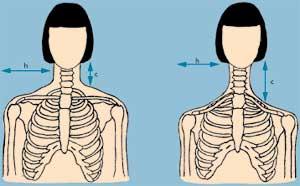Giraffe women
However, we know little about the peoples who have lived for centuries in these mountains. These areas have been the site of forests, closed jungles and water rivers that are still today elephant shelters and that until ten years ago were almost unknown.
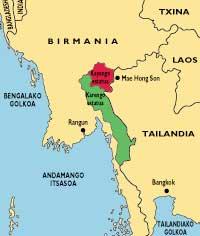
In these high areas we can find villages, called mountain tribes. Among these ethnicities are: karen, iu, mien, akha, lahu, hmong and lisu. It must be said that some of them have their origin in Tibet and China.
Although each group has its own forms of life and tribal characteristics, the “giraffe” is the female people that most surprises us. The name does not refer to the height of women (who do not reach a meter and a half) but to the height of their neck. The women of the place have the longest necklaces that can be seen somewhere, adorned with elegant golden necklaces.
The strangeness of these women has made them a spectacle for tourists and their attitude against the military authorities of Burma forces them to seek refuge in neighboring states. How is that people? How did they get their long necklaces?
Kayan village
Padung o kayan is one of the four subgroups of the Karen ethnicity. Karen is a name chosen by anthropologists to designate peoples with Tibetan-Burmese roots and similar languages. Those of the Karen ethnicity have no special words to designate the entire population of their ethnicity, but within each ethnic group they have the proper word that fulfills that function, which means “people” in each language. As for the tribe of the Giraffe women, that word is kayan (Latin phonetics).
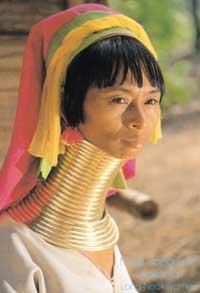
Although they currently live on the border between Burma and Thailand (see figure 1), we do not know their origin and their time in the area. This mountainous region lies within a large mountain range. This mountain range, started in Tibet and spread over the territories of Burma and northern and western Thailand, has several rocky peaks of between 1,000 and 3,000 meters. A Christian missionary reported on the Kayan people in the 19th century. For the first time at the beginning of the century. According to language characteristics, from the northern territories, perhaps from Tibet, II. and VII. It is believed that they have gone between centuries, but that is nothing more than belief.
Kayan is a small village, has no more than twenty houses and the houses are grouped according to the roots of his mother. The houses are built of wood and bamboo and place the floor of the house above the ground. It also has a space to receive visits, a small covered portal. Inside the house is a single room with kitchen, in which bionbos are used to preserve the privacy of single women. They usually place the barns together or under the house. They have no altars at home because they are Christians.
The family consists of marriage and the children who live at home until the time of marriage. As for sexual morality, it should be noted that it is very strict and that when unmarried women become pregnant, they get married as soon as possible. When it comes to adultery, one or both members of the adulterating couple are expelled from the village. Divorce is difficult and widowed men cannot remarry unless they have children; the house and children are property of the woman (her wife or her spirit).
When marriage dies, housing and minor livestock (birds, etc.) dissolve. The duration of the funerals depends on the resources of each moment and to it all the neighbors of the town, as well as the relatives of the deceased.
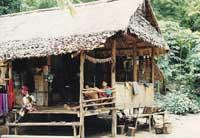
The land where the Kayanas live is below that of the rest of the Ka ethnic group. The topics covered are rice, corn, sorghum, cotton and pumpkin. To do this, in the jungle, by igniting small bonfires that only destroy the shrub layer and the upper parts of the trees, get clear. Through this procedure, soil fertility is not affected and once harvested the forest can be redeveloped. This method has led them to a tendency to sedentarism and led them away from the cultivation of opios. It should be noted that kayans produce much less heroin than those of other nearby villages.
Origin of the collado
Kayan has several legends to explain why women stretch their neck. The oldest of these legends is the so-called “Dragon Story” which says:
“Formerly the long-necked dragon fell in love with the wind and the wind fertilized it. From this connection arose the first human kayan. Since then, Kayan women stretch their necks to impersonate a mother dragon.”
Another legend indicates:

“A princess Kayan had a golden tree. When the Burmese entered their territories, for fear of being robbed, he pulled the tree from the ground and placed it around his neck. After the victory of the Burmese army, the princess was slaughtered and dragged. In honor of the princess, the Kayan women wore the Gold Mode.”
There are other explanations. For example, the one who mentions the protection that collars could give to the great beasts. Many centuries ago, apparently, when men were heading for hunting, rings were placed on the neck so that the tigers would not swallow them. The women also did the same, but for aesthetic reasons, since among the women there was some competition to get the neck longer and beautiful.
Legends, according to the anthropologists of Txiang Mai University, those of collar could indicate that formerly women were dominated by men. According to some researchers, it was a way to avoid ohaity: when adultery occurred, the woman was removed from her collar. Losing her head and falling, the woman died drowned. According to others, the necklaces were used to “meet” the women of the group, so that the women were not kidnapped by outsiders.
However, and although some explanations seem more credible than others, the reason for the necklace has not yet been clarified.
Conclusions of Idoia

The necks of the Kayan women are formed by brass rings 1 cm thick. For girls, the first set of rings is usually applied at nine or ten years of age, and as they grow older, each year another ring is placed on the neck until the young girl marries. The implementation and modification of these rings is supervised by the oldest women in the municipality.
Kayan believes that long hills are a sign of beauty. Therefore the longer, the more precious. Let’s say, as an example, that adult women can have an “elegant” neck of 30 cm, which requires a necklace of 24 rings of 5 kg of total weight.
But it is not the neck, the only location of the necklaces mentioned. Also on the ankles and bracelets are often placed several rings, until in some cases the bern and counterpoint are covered. The preservation of the shine of these rings and the prevention of superficial diseases demand a great deal of work. Women clean and dry rings every day.
The Kayans have to wear necklaces for a lifetime, as the head does not hold on its own and once dead they are buried next to the necklaces.
When Kayan looks at women, the first question that comes to the head is how is it possible that the neck is so long? It has long been believed that the rings “stretched” the literate vertebrae, but today we know that this is false and that the name “giraffe” is not anatomically appropriate.
Collars do not alter the structure of the vertebrae. As a result, the nails and the first willows are compressed. Over time, these bones twist and fall below the normal position, so the shoulders “disappear” (see figure 2). This is what appeared on X-rays made by the National Geographic Society to women in different kayas.
This change in bones can explain the different diameters of the rings on the neck and shoulders. In the case of girls, although all the rings that form the necklace are the same size, as the clavicles are tilted, the diameter of the rings that are on them should be increased.
As already indicated, although the necklaces only act on the shoulder, seeing women seems to have elongated their neck. In order to hide the effect on the shoulder and highlight the “stretch” of the neck, in the kayan women use scarves that somehow cover the upper parts of the back and chest.
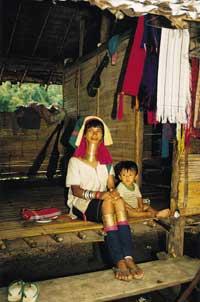
Obviously, the necklaces they use cause various problems in the body, but how do they influence women's lives?
As for the movement of the head, women have little ability to turn their heads from left to right, but they cannot move forward or backward. When they are standing, if they want to see the feet, they have to bend the trunk. And any other movement of the body is also difficult due to the enormous stiffness given to it by the rings of the neck, arms and legs. For example, to drink any liquid (water, soup...) you also need to use straws.
Although giraffe is a fragile and rigid aspect of women, they do not resist their duties and we can see them in the countryside and at home.
Future
Burma's territories, located on the border of Thailand, have been for centuries in the hands of the Ka's ethnicity (see figure 1). Karen and the Kayan were independent states until the British mandate began in 1886. After its completion in 1948, the federal state was held in Burma, but the total empowerment of the Burmese Burmese made the Ka take up arms to defend their territory. Since then they have fought for their independence. Currently, kayans and other ethnic groups of ka have also met in Myanma (S.L.O.R.C.) are suffering the attack and these peoples give great help to student and guerrilla groups.
The Burmese army does not allow the Kayans to cultivate their lands and expel them from their villages. Melvin J. Wang, a monitor sent by the UN, has lived in recent years with Karen and Kayan, and has highlighted the precarious situation of this forgotten people both west and east: “Because of food problems, malaria continues to spread in the villages. For many days people don't have a cup of rice to eat. Children are the most affected, there are no doctors or teachers... Men are taken by the army to work as guides and showers or killed.”
As a result of this situation, migration to the states of the area, especially that of Thailand, is constantly growing. According to the latest data, in Thailand live more than 300 kayas grouped in Nupa-ah and Nam Pin Den. Thirty of them are giraffe women. It should be noted that the Government of Thailand cedes the territories to refugees of the Karen ethnicity to remain there.
The rise of tourism has made kayan women an important source of income for the small villages they live in and an invaluable aid to the action of the guerrillas. Although in this situation women necklaces seem to be part of a “human zoo”, unfortunately it is only a way to survive.
Kayan's long necklaces of women are disappearing, no doubt, because this town tries to adapt to an increasingly industrial and modern Thai society. However, girls with the first set mode can still be seen in remote places.
